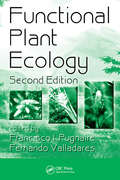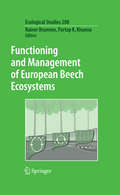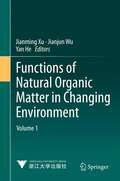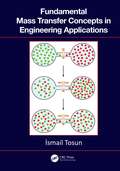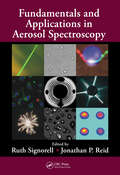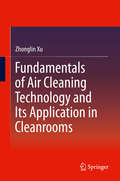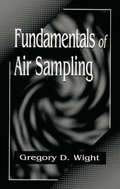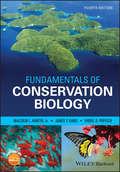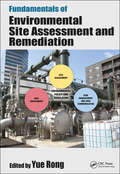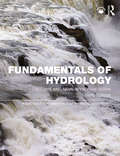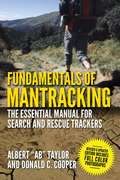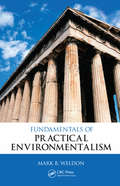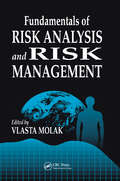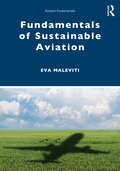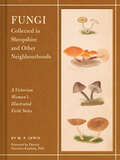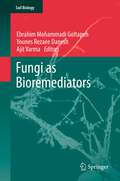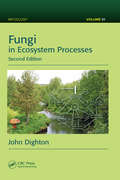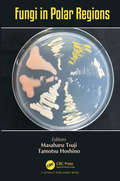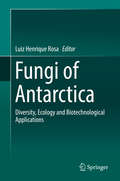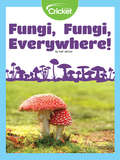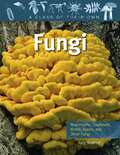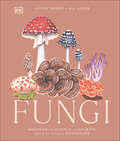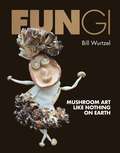- Table View
- List View
Functional Plant Ecology (Books in Soils, Plants, and the Environment)
by Francisco I. Pugnaire Fernando ValladaresFollowing in the footsteps of the successful first edition, Functional Plant Ecology, Second Edition remains the most authoritative resource in this multidisciplinary field. Extensively revised and updated, this book investigates plant structure and behavior across the ecological spectrum. It features the ecology and evolution of plant crowns and a
Functioning and Management of European Beech Ecosystems
by Rainer Brumme Partap K. KhannaThis volume compiles the results of long-term observations of site properties and ecosystem processes for three beech forests. Representing a spectrum of common beech forest sites in Central Europe, they receive similar atmospheric inputs and are growing under similar climatic conditions, but differ in their soil acidity. Significant differences were observed in the diversity and activities of fauna and microbes in these soils, which was the major driving variable for the nutrient cycling processes, growth patterns, greenhouse gas emissions and the C and N sequestration in these forests. Differences in N and C contents and cycling among the three beech sites represented three phases (quasi steady-state, accumulation and degradation) as described by ecosystem theory on the functioning and historical development of the N dynamic of other 50 European ecosystems. Various implications for the future management of these and similar beech sites are discussed.
Functions of Natural Organic Matter in Changing Environment
by Jianming Xu Jianjun Wu Yan HeFunctions of Natural Organic Matter in Changing Environment presents contributions from the 16th Meeting of the International Humic Substances Society (IHSS 16) held in Hangzhou, China on September 9-14, 2012. It provides a comprehensive and updated research advance in the field of characterization, function, application of humic substances (HS) and natural organic matter (NOM) in environment, agriculture, and industry. A broad range of topics are covered: i) formation, structure and characteristics of HS and NOM; ii) HS/NOM and carbon sequestration; iii) HS/NOM and biogeochemical cycling of nutrients; iv) HS/NOM and the environmental processes of toxic elements and anthropogenic organics; v) HS/NOM, naturally occurring and engineered nanoparticles; vi) HS/NOM, biodiversity and ecosystem health; vii) HS/NOM in water and water treatment; viii) characterization and function of biochar in the environment; and ix) industrial products and application of HS. The book will be an invaluable reference for chemists, biologists, environmental scientists, ecologists, soil scientists, water scientists, agronomists, global change researchers and policy makers. Jianming Xu is Professor and Director at the Institute of Soil and Water Resources and Environmental Science, Zhejiang University, Hangzhou, China. Jianjun Wu is Professor at the Institute of Soil and Water Resources and Environmental Science, Zhejiang University, Hangzhou, China. Yan He is Associate Professor at the Institute of Soil and Water Resources and Environmental Science, Zhejiang University, Hangzhou, China.
Fundamental Mass Transfer Concepts in Engineering Applications
by Ismail TosunFundamental Mass Transfer Concepts in Engineering Applications provides the basic principles of mass transfer to upper undergraduate and graduate students from different disciplines. This book outlines foundational material and equips students with sufficient mathematical skills to tackle various engineering problems with confidence. It covers mass transfer in both binary and multicomponent systems and integrates the use of Mathcad® for solving problems. This textbook is an ideal resource for a one-semester course. Key Features The concepts are explained with the utmost clarity in simple and elegant language Presents theory followed by a variety of practical, fully-worked example problems Includes a summary of the mathematics necessary for mass transfer calculations in an appendix Provides ancillary Mathcad® subroutines Includes end-of-chapter problems and a solutions manual for adopting instructors
Fundamentals and Applications in Aerosol Spectroscopy
by Ruth Signorell Jonathan P. ReidHelping you better understand the processes, instruments, and methods of aerosol spectroscopy, Fundamentals and Applications in Aerosol Spectroscopy provides an overview of the state of the art in this rapidly developing field. It covers fundamental aspects of aerosol spectroscopy, applications to atmospherically and astronomically relevant problem
Fundamentals of Air Cleaning Technology and Its Application in Cleanrooms
by Zhonglin XuFundamentals of Air Cleaning Technology and Its Application in Cleanrooms sets up the theoretical framework for cleanrooms. New ideas and methods are presented, which include the characteristic index of cleanrooms, uniform and non-uniform distribution characteristics, the minimum sampling volume, a new concept of outdoor air conditioning and the fundamentals of leakage-preventing layers. Written by an author who can look back on major scientific achievements and 50 years of experience in this field, this book offers a concise and accessible introduction to the fundamentals of air cleaning technology and its application. The work is intended for researchers, college teachers, graduates, designers, technicians and corporate R&D personnel in the field of HVAC and air cleaning technology. Zhonglin Xu is a senior research fellow at China Academy of Building Research.
Fundamentals of Air Sampling
by Gregory D. WightThere is a growing need for environmental measurement personnel who possess a solid understanding of the techniques of air pollutant sampling. This essential book explains the fundamentals of air sampling, develops the theory of gas measurement, and presents several "how-to" examples of calibration and use of air and gas sampling devices. Other topics covered range from the basics of pressure measurement and units conversion to specific discussions regarding the use of a Volatile Organic Sampling Train or a SUMMA-polished canister sampling system.
Fundamentals of Conservation Biology
by Malcolm L. Hunter Jr. James P. Gibbs Viorel D. Popescu“This book is about hope in the face of forces that would degrade our world. This book is about the rich tapestry of life that shares our world now and about how we can maintain it, sometimes in places that we protect and set aside, more often in places where we share the lands and waters with a wide range of other species.” For more than 30 years, Fundamentals of Conservation Biology has been a valued mainstay of the literature, serving both to introduce new students to this ever-changing topic, and to provide an essential resource for academics and researchers working in the discipline. In the decade since the publication of the third edition, concerns about humanity’s efforts to conserve the natural world have only grown deeper, as new threats to biodiversity continue to emerge. This fourth edition has taken into account a vast new literature, and boasts nearly a thousand new references as a result. By embracing new theory and practice and documenting many examples of both conservation successes and the hard lessons of real-world “wicked” environmental problems, Fundamentals of Conservation Biology remains a vital resource for biologists, conservationists, ecologists, environmentalists, and others.
Fundamentals of Environmental Site Assessment and Remediation
by Yue RongFundamentals of Environmental Site Assessment and Remediation examines all aspects of environmental site assessment and remediation and outlines the interdisciplinary skills needed to work in the field. It provides a comprehensive overview for students, environmental professionals, and real estate developers, and includes the latest environmental regulations, environmental site assessment and remediation practices, and industry standards. It examines pollution sources and the related impacts on drinking water supplies, the associated health risks, and how to protect water resources. The monitoring of surface water, groundwater, and soil is explained, as well as vapor intrusion. It will include several practical case studies throughout. Features Includes the latest and best practices for environmental site assessment and remediation procedures. Presents a multidisciplinary approach, including environmental forensics, nanotechnology, microbiology (DNA technology) and isotopes, etc. Examines various pollutants and their related impacts on drinking water supplies, the associated health risks, and how to protect water resources. Presents the best practices for the monitoring of surface water, groundwater, and soil. Covers the latest environmental regulations and industry standards.
Fundamentals of Hydrology (Routledge Fundamentals of Physical Geography)
by Tim DavieThe third edition of Fundamentals of Hydrology provides an absorbing and comprehensive introduction to the understanding of how fresh water moves on and around the planet and how humans affect and manage the freshwater resources available to them. The book consists of three parts, each of fundamental importance in the understanding of hydrology: The first section deals with processes within the hydrological cycle, our understanding of them, and how to measure and estimate the amount of water within each process. This also includes an analysis of how each process impacts upon water quality issues. The second section is concerned with the measurement and analytical assessment of important hydrological parameters such as streamflow and water quality. It describes analytical and modelling techniques used by practising hydrologists in the assessment of water resources. The final section of the book draws together the first two parts to discuss the management of freshwater with respect to both water quality and quantity in a changing world. Fundamentals of Hydrology is a lively and accessible introduction to the study of hydrology at university level. It gives undergraduates a thorough understanding of hydrological processes, knowledge of the techniques used to assess water resources, and an up-to-date overview of water resource management. Throughout the text, examples and case studies from all around the world are used to clearly explain ideas and techniques. Essay questions, guides to further reading, and website links are also included.
Fundamentals of Mantracking: The Step-by-Step Method: An Essential Primer for Search and Rescue Trackers
by Donald C. Cooper Albert Ab" TaylorRevised and updated with color photographs, the classic guide to search and rescue.In 2012, there were 661,000 missing person cases opened in the United States. While the majority of missing person cases that get opened are closed quickly, by the end of the year over 2,000 remained unresolved. In many instances, when the missing person is lost in the woods, or in the desert, search and rescue missions become an essential tool that can mean the difference between life and death. <p><p>Fundamentals of Mantracking is the essential guide written by the people who spent most of their lives developing and refining the art of tracking, one of the most important but often overlooked aspects of successful search and rescue missions. <p><p>Inside, you will find the history of tracking, information on how to tell when tracking becomes necessary, recommended equipment and tools, and hundreds of indispensable examples of what to do on your way to becoming an expert tracker. <p><p>Originally released in 1990, the revised and updated edition of Fundamentals of Mantracking includes dozens of color photographs and detailed illustrations, making it the one book essential to anyone interested in learning how to track, or committed to becoming the best tracker possible.
Fundamentals of Practical Environmentalism (Social Environmental Sustainability)
by Mark B. WeldonEnvironmental decisions present themselves every day in forms large and small. Should I walk to work today? What about global warming-should I write my congressperson and demand that the government do something? Should I put solar panels on my roof? Should I get a different car or turn up the temperature on the air conditioner or get water-saving f
Fundamentals of Risk Analysis and Risk Management
by Vlasta MolakThis book bridges the gap between the many different disciplines used in applications of risk analysis to real world problems. Contributed by some of the world's leading experts, it creates a common information base and language for all risk analysis practitioners, risk managers, and decision makers.Valuable as both a reference for practitioners and a comprehensive textbook for students, Fundamentals of Risk Analysis and Risk Management is a unique contribution to the field. Its broad coverage ranges from basic theory of risk analysis to practical applications, risk perception, legal and political issues, and risk management.
Fundamentals of Rural Development
by Bikram Keshari PattanaikThe book expounds on the functioning of rural development as well as the practical problems encountered in the formulation of rural development policies and programmes. It provides an exhaustive account of the various sectors and actors of rural development and presents it as a multidimensional concept by documenting its different components. It also details the paradigms and strategies of rural development adopted by developed and developing countries of the world.This volume deals with rural cooperatives and livelihood in order to understand how the development process can be self-sustained and sustainable, following the vocal for local mantra. It also extensively discusses rural basic needs, poverty, employment, the role of Panchayati Raj institutions, the corporate sector, NGOs, peoples’ participation, and capacity building in rural development.This book will be useful to undergraduate and postgraduate students, researchers, and teachers of development studies, economics, sociology, political science, and public administration. It will be useful for the administrators and development administration officials of state and central government, planners, policymakers, and people working in NGOs and corporate sector functionaries dealing with corporate social responsibilities especially those handling developmental issues and challenges.
Fundamentals of Sustainable Aviation (Aviation Fundamentals)
by Eva MalevitiFundamentals of Sustainable Aviation is the first textbook to survey the critical field of sustainability within the aviation industry. Taking a systems thinking approach, it presents the foundational principles of sustainability and methodically applies them to different aviation sectors. Opening with the basics of sustainability, emphasising the Sustainable Development Goals, the book then considers the environmental, economic and social dimensions of aviation. The following chapters apply these insights to aviation design, supply chains, operations, maintenance and facilities. The final chapter examines the concept of resilience in sustainable aviation. Overall, the textbook shows how future sustainability can be achieved by making better decisions today. Students are supported with international case studies throughout the book. Slides, test questions and a teaching manual are available for instructors. This textbook is the ideal resource for courses on sustainable aviation globally and will also be of great interest to professionals in the field.
Fundamentals of Sustainable Aviation (ISSN)
by Eva MalevitiFundamentals of Sustainable Aviation is the first textbook to survey the critical field of sustainability within the aviation industry. Taking a systems thinking approach, it presents the foundational principles of sustainability and methodically applies them to different aviation sectors.Opening with the basics of sustainability, emphasising the Sustainable Development Goals, the book then considers the environmental, economic and social dimensions of aviation. The following chapters apply these insights to aviation design, supply chains, operations, maintenance and facilities. The final chapter examines the concept of resilience in sustainable aviation. Overall, the textbook shows how future sustainability can be achieved by making better decisions today.Students are supported with international case studies throughout the book. Slides, test questions and a teaching manual are available for instructors. This textbook is the ideal resource for courses on sustainable aviation globally and will also be of great interest to professionals in the field.
Fungi Collected in Shropshire and Other Neighbourhoods: A Victorian Woman's Illustrated Field Notes
by M. F. LewisVenture into the woods alongside a pioneering female mycologist. This one-of-a-kind, keepsake volume celebrates the timeless fascination of fungi.Very little is known about M. F. Lewis—not even her first name. Mysterious, prolific, and deeply enamored with the world of mushrooms, she left us a treasure trove of mycological illustrations. For over forty years, from 1860 to 1902, Lewis rambled across England and Wales, recording an astonishing biodiversity of fungi. Her delicately drawn, boldly colored images evoke the strange and powerful beauty of this kingdom. This handsome volume collects hundreds of Lewis's watercolors, contextualized by a foreword from mycologist Dr. Patricia Ononiwu Kaishian. It's a must-have for today's mushroom lovers who are curious about the history of mycology and for any admirer of vintage botanical illustration who wants to discover something different.FASCINATING FUNGI: Mushrooms are having a real moment, but they've always captured our imaginations, even in Victorian times. Lewis's gorgeous artwork offers the modern mushroom fan a new way to appreciate their favorite kingdom.VINTAGE AESTHETIC: This lovely clothbound volume evokes the magic of uncovering a treasure in a jumbled vintage bookstore. FEMINIST HISTORY: While little is known of the elusive M. F. Lewis, we can celebrate the legacy that she and other female naturalists of the 19th century left for women in science and art today.ARTFUL SCIENCE: Lewis's illustrated field notes showcase the intersection of art and science at its best.Perfect for:Mushroom hunters, eaters, and admirersFans of cottagecore and goblincore aestheticsCollectors of vintage books and vintage botanical illustrationCollectors of Victorian ephemeraReaders of feminist historyEnvironmentalists, scientists, and artists
Fungi as Bioremediators
by Ajit Varma Ebrahim Mohammadi Goltapeh Younes Rezaee DaneshBiological remediation methods have been successfully used to treat polluted soils. While bacteria have produced good results in bioremediation for quite some time now, the use of fungi to decontaminate soils has only recently been established. This volume of Soil Biology discusses the potentials of filamentous fungi in bioremediation. Fungi suitable for degradation, as well as genetically modified organisms, their biochemistry, enzymology, and practical applications are described. Chapters include topics such as pesticide removal, fungal wood decay processes, remediation of soils contaminated with heavy and radioactive metals, of paper and cardboard industrial wastes, and of petroleum pollutants.
Fungi in Ecosystem Processes (Mycology #Vol. 17)
by John DightonThis new edition of Fungi in Ecosystem Processes continues the unique approach of examining the roles of fungi from the perspective of ecosystem functions. It explores how fungi have adapted to survive within particular constraints, how they help to maintain homeostasis in ecosystems, how they facilitate resistance to perturbations, and how they influence the communities of other organisms. Updated and revised, the second edition Expands the section on plant pathogens, invasive species, and insect–fungal interactions Provides more extensive coverage on insect–fungal interactions, including entomopathogens, the links between entomopathogens and endophytes, and symbiotic and mutualistic interactions Adds a new section on fungi in the built environment Presents new material on below-ground to above-ground interactions mediated through fungi, such as mycorrhizal signaling systems for herbivory defense The book also includes expanded coverage of the role of fungi in suppressive soils, aquatic and marine fungi, modern methods of following food chains in fungal–invertebrate trophic interactions, and the physiology of nutrient uptake by mycorrhizae. A necessary update and expansion to previous material, this book provides an essential reference on the current understanding of fungal roles in ecosystem processes. It also identifies directions for future study, including an emphasis on the need for further research on fungi in built environments.
Fungi in Polar Regions
by Masaharu Tsuji Tamotsu HoshinoFungi that inhabit polar-region can grow and decompose organic compounds under subzero temperatures play important roles in the nutrient cycle of polar-region ecosystems. Thus, changes in the mycoflora affect the ecological recycling in these regions, and understanding the cold-adaptation strategies of fungi under extreme environments is critical for a better understanding of polar-region ecosystems. Due to their ability to survive under extreme environments, fungi in polar-region are seen to show potential for utilization in biotechnologies. This book presents our current understanding of the mycoflora in polar-region and their cold adaptation strategies, and applied studies using their abilities.
Fungi of Antarctica: Diversity, Ecology and Biotechnological Applications
by Luiz Henrique RosaThis book focuses on the fungi found in one of the most pristine regions on Earth: Antarctica. It discusses the fungal occurrence in all substrates of the region, including soil, seawater, lake and marine sediments, rocks, ice, and snow. It also addresses the impact of climate changes on these organisms, the genomic techniques developed to study them, and how a number of compounds, such as antibiotics and enzymes, produced by the Antarctic fungi can be used in medicine, agriculture and the chemical industry.
Fungi, Fungi, Everywhere!
by Gail JarrowWhat comes to mind with you think of fungi? Is it mushrooms, or perhaps mildew? Mold and yeast are fungi, too! Learn all about how fungi reproduce with spores, and how their bodies are made up of mycelium!
Fungi: Classifying Mushrooms, Toadstools, Molds, Yeasts, and Other Fungi (Class of Their Own)
by Judy WearingThere are hundreds of thousands of different known fungi with many still to be discovered and developed. This interesting book features an examination of the four major groups: yeasts, toadstools, chytrids, and bread molds. <p><p>Key characteristics of fungi are highlighted, such as spore production, fungi's need to feed, and their use of long, branching cells known as hyphae to absorb nutrients from the environment. Special sections explore such varieties as saprophytes, which feed on dead and decaying matter; parasites, which often do considerable harm to other species; and species that form mutualistic relationships with other species to form composite organisms, such as lichen. Case histories involving fungi include penicillin and the fight against disease, and genetically modified (GM) products in food technology.
Fungi: Discover the Science and Secrets Behind the World of Mushrooms (British Mycological Society Symposia Ser. #Series Number 15)
by Lynne Boddy Ali AshbyA stunning, authoritative book on the fungal kingdom, uncovering the hidden world of more than 300 global speciesDiscover the fascinating stories behind 300 species of fungi and understand the world of mushrooms like never before!Did you know that fungi put the fizz in champagne and the flavor in chocolate? Fungi is everywhere we look in a forest, under the sea, and in the kitchen.In this beautiful book, leading fungal biologists Lynne Boddy and Ali Ashby bring you closer to 300 species of mushrooms and lichens through fascinating facts, mushroom datasets, and detailed illustrations. Discover some of the fastest speeds in nature, specimens that glow in the dark, and fungi that clean up oil spills.Humans have had a close relationship with mushrooms for thousands of years-from using the shiitake for healing, to telling stories of enchanted fairy rings, to cooking gourmet dishes with rare specimens. Bringing together technology, medicine, food, culture, and nature, this fascinating book will open your eyes to the wonders of the hidden kingdom all around us.With tips for mushroom spotting in any habitat, species identification notes, a grow-your-own guide, and more, this book is the ultimate fungi lover's companion.
Fungi: Mushroom Art Like Nothing on Earth
by Bill WurtzelWelcome to a kingdom of mushroom art and foraged facts. Where most people might see dinner, visual artist Bill Wurtzel sees people, animals, and more. Within these pages, he puts the fun in fungi with his whimsical and inspired creations, beautifully posed and photographed. Accompanied by text revealing the world of mushrooms, white button, portabella, maitake, and king trumpets are transformed into people dancing, riding hot air balloons, tight-rope walking, exercising, and so much more. All sorts of members of the animal kingdom are recreated in this charming style, including cats, dogs, elephants, owls, and chickens. Both amateur mycologists and expert foragers will see mushrooms in a new light as their shapes and textures capture joyous experiences and emotions, proving just one more way mushrooms can be beneficial to all of us. Pull up a toadstool and take in the magical sights!
